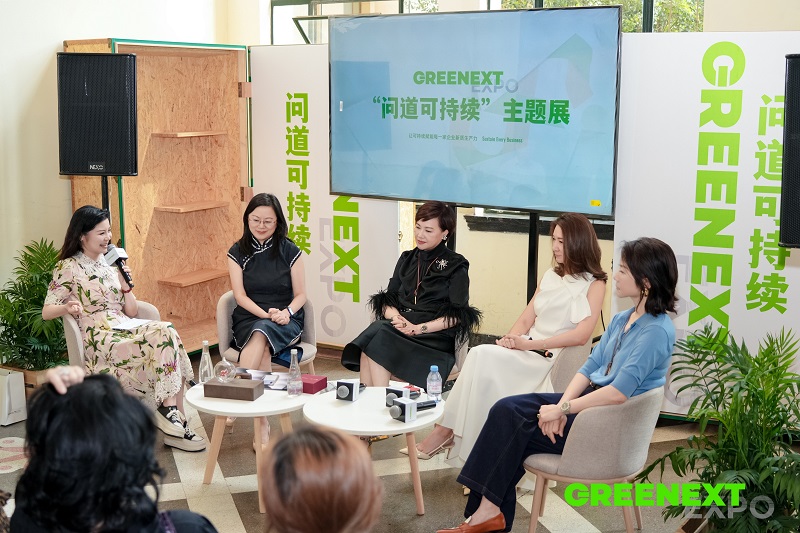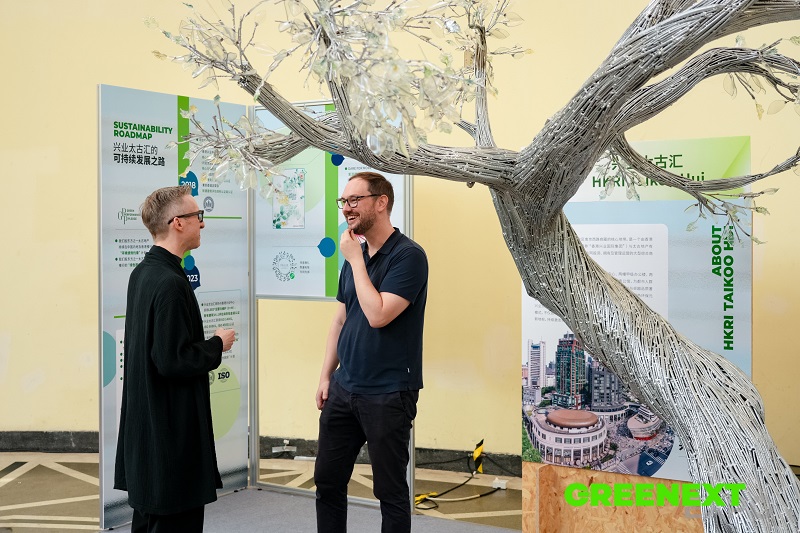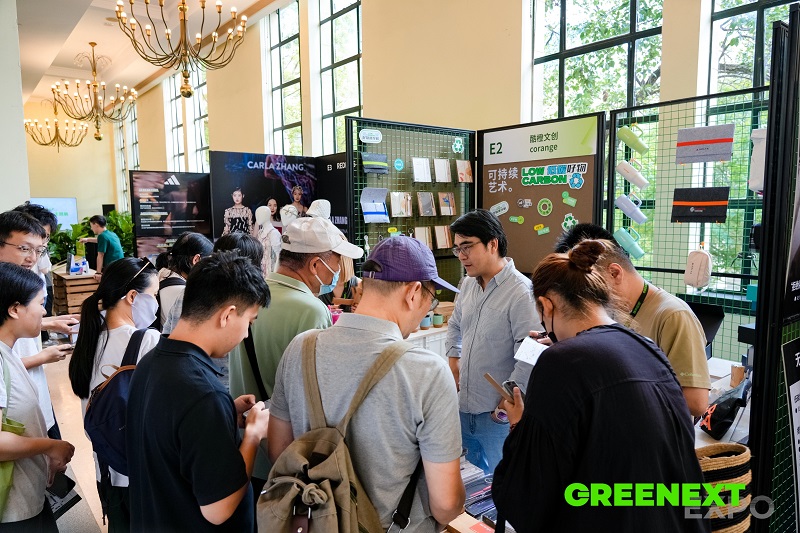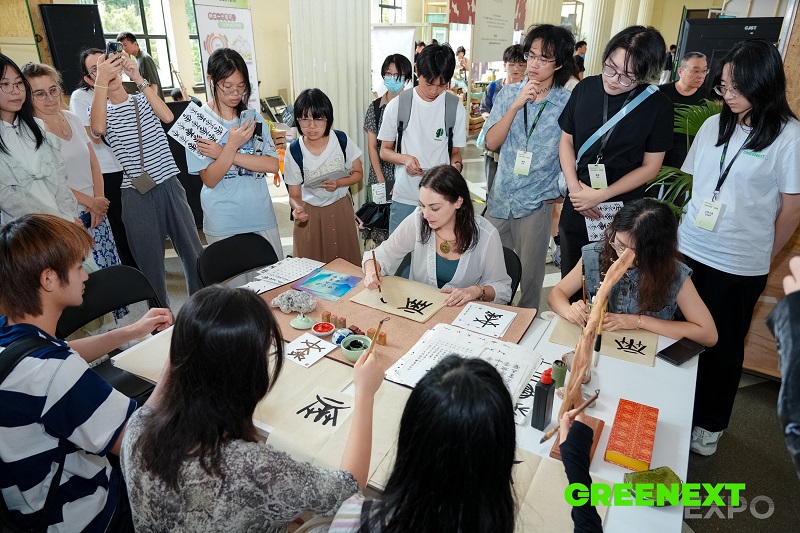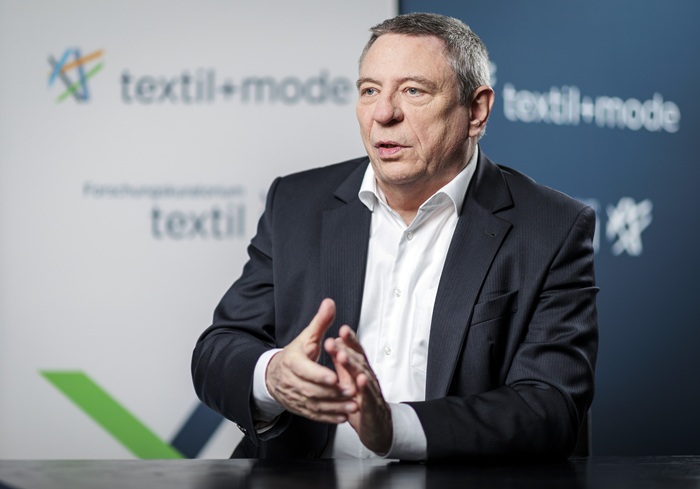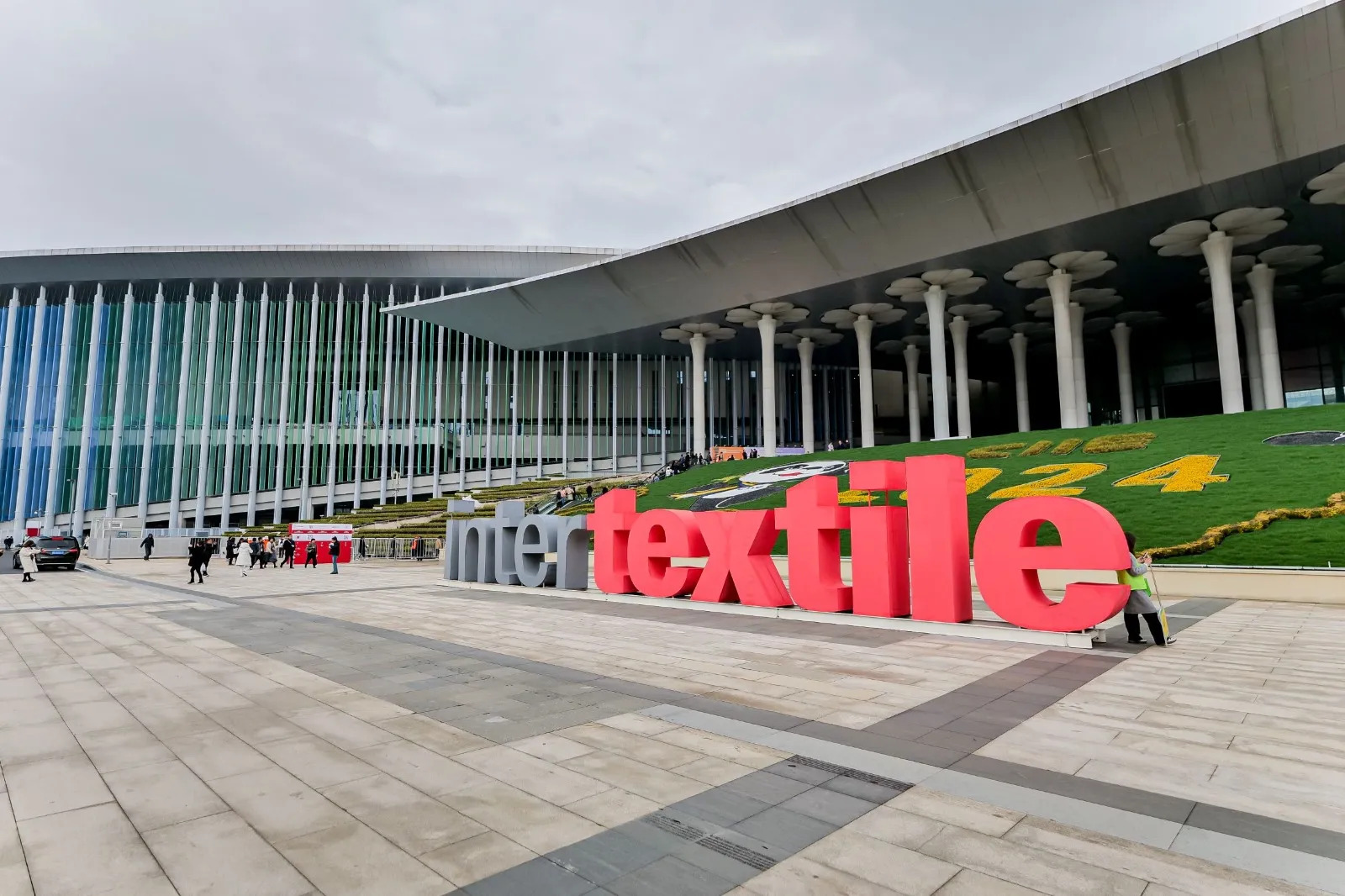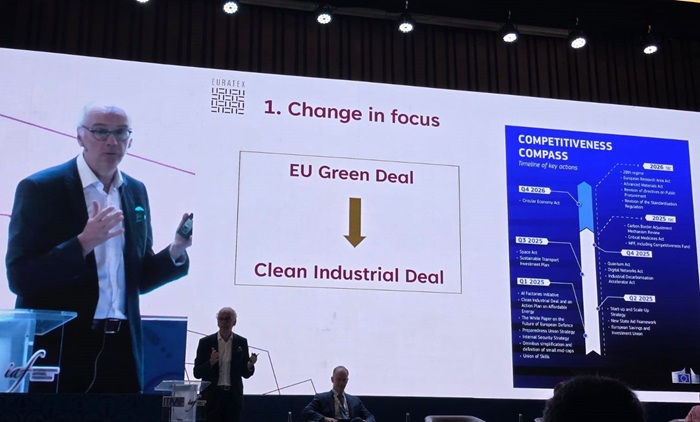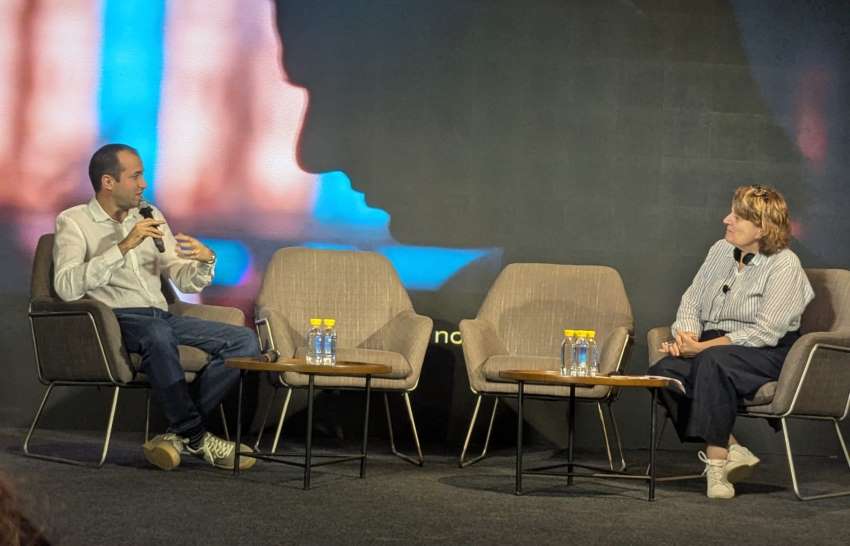FW
The GREENEXT Expo 2025, held over two days on September 26-27, 2025 at the Shanghai Exhibition Center, not merely as a showcase, but as a crucial nexus for turning green ideals into profitable, scalable business models. Attracting 5,022 attendees and featuring solutions from over 120 enterprises, the event championed a model defined by Sustainability Innovation × Cross-Sector Collaboration × Business.
From 'Why' to 'How': A call for tangible solutions
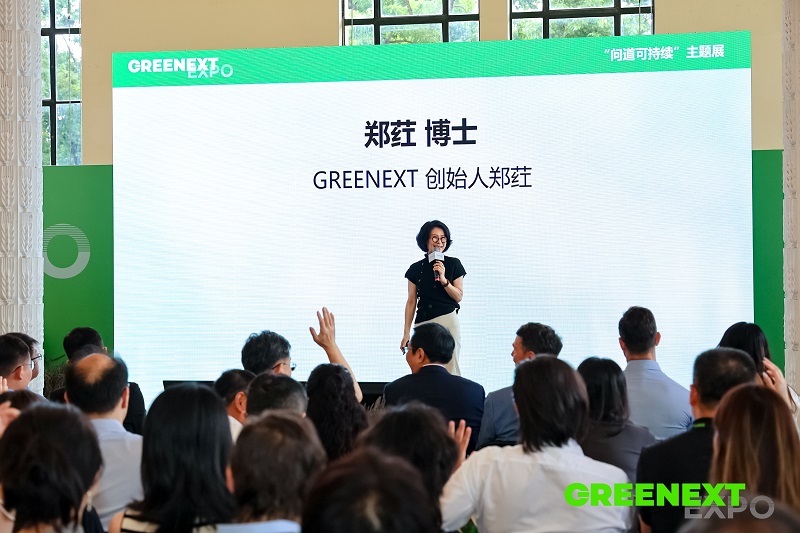
The Expo's central message—that sustainability has moved past debate into execution—was articulated by Dr. Hong Zheng, Founder of GREENEXT, in her rousing keynote, “Sustainability is a journey carried by tangible solutions—from product design to business models, from technological innovation to cultural expression, transforming green ideals into perceptible, tangible, and communicable practices,” Dr. Zheng stated.
The focus was sharp: transitioning the discussion from a philosophical "why" to a practical "how." The event targeted four critical commercial scenarios essential for driving China's green economy forward: Urban Regeneration, Global Expansion (building trust in cross-border supply chains), Technological Innovation (unleashing youth creativity), and embedding Public Good for enduring business competitiveness. “Our shared mission is to ensure businesses thrive sustainably while fostering an enduringly prosperous planet", emphasied Dr. Hong Zheng.
The Six Zones: Where fashion meets regenerative farms
The exhibition floor mapped out the full spectrum of the sustainable value chain across six dedicated thematic zones, offering more than 200 case studies.
● The Fashion Forward zone directly confronted the textile industry's high-impact footprint, showcasing everything from green raw materials to smart manufacturing. Leading brands like adidas and the Ellassay Group presented innovative pathways toward circular fashion.
● Living Earth connected consumers directly to nature, spotlighting regenerative agriculture and responsible sourcing. Exhibitors like The Macallan detailed transparent supply chains—from “field to bottle”—rediscovering the value of green raw materials in daily life.
● The Green for Next zone focused on corporate transformation, with giants such as HKRI Taikoo Hui and Tencent CarbonXmade showcasing solutions for carbon auditing, green investment, and building resilient circular systems.
Global dialogue and the new aesthetic of luxury
The conference track was a cornerstone of the Expo, featuring 183 global experts across 77 events, including a series of high-level panel discussions.
The dialogue extended beyond traditional environmental topics to redefine commercial value. Ruifang Ding of HKRI Taikoo Hui captured this new paradigm perfectly, introducing the concept of "The Third Aesthetic of Commercial Spaces: Making Sustainability the New Luxury," offering fresh perspectives for the green transformation of commercial real estate. Meanwhile, the presence of consuls from Nordic nations like Finland, Norway, Belgium, and Denmark underscored the Expo's commitment to Global Collaboration in solving complex supply chain and regulatory challenges.
Initiatives for Tomorrow: Youth, funds, and philanthropy
GREENEXT 2025 cemented its commitment to a sustainable future with several significant launches and awards.
At the Innovation Hub, the official release of the Youth Action Guide for Sustainable Development aimed to mobilize the next generation of innovators. Further underlining the blend of commerce and altruism, the Shanghai Population Welfare Foundation Sustainable Development Fund was jointly announced, promoting the integration of philanthropy and corporate sustainability. The event also celebrated industry leaders at the Global Sustainable Fashion Consumption Industry Pioneer Awards Ceremony.
The human element was profoundly felt at the opening, featuring a heartfelt drum performance by the Love.Disabilities.Love charity initiative and a circular fashion charity dance led by Ambassador Flora Zeta Cheong-Leen, powerfully showcasing social value.
The Sustainable Journey: Public engagement goes interactive
Beyond the halls of commerce and conference, the Expo captivated the public with its specially curated "Sustainable Journey." This immersive route combined art and technology, encouraging visitors to participate in hands-on activities to earn "sustainable rewards."
Highlights included the Climate Fresk workshop, adidas’ Clothes Recycling Green Initiative, and the engaging Plateau × Ocean × City Recycled Plastic Workshop, which transformed complex issues into accessible, hands-on experiences.
GREENEXT Expo 2025 successfully transitioned the dialogue from aspiration to activation, confirming its status as a vital platform for sustainable development in China. Preparations are already underway for the 2026 event, promising to deepen the commitment to co-creating a greener tomorrow.
The Indian Government has extended the Remission of Duties and Taxes on Exported Products (RoDTEP) Scheme for an additional six months, ensuring its continuation until March 31, 2026. This decision by the Directorate General of Foreign Trade (DGFT) comes at a critical time, as Indian exporters face significant headwinds, including 50 per cent reciprocal tariffs imposed by the United States. The extension is intended to provide crucial support and policy certainty to the export sector.
Refunding various central and state duties, taxes, and levies that are not reimbursed under other mechanisms, the RoDTEP scheme will continue to apply its existing rates to all eligible export items. The scheme is compliant with World Trade Organization (WTO) provisions and covers a vast range of products, including over 8,555 items like yarn, sarees, and lungis from the textile industry.
The DGFT's notification confirms, the scheme will remain in force for exports made by Domestic Tariff Area (DTA) units, Advance Authorisation (AA) holders, Special Economic Zone (SEZ) units, and Export Oriented Units (EOUs). However, the operation of the scheme will be managed within the approved budgetary framework of the Foreign Trade Policy (FTP) 2023 to ensure that total remissions during the financial year remain within the allocated limits.
The global sportswear market is forecasted to reach a value of $837 billion by 2035, growing at a 7.6 per cent CAGR from 2024, according to Stratilligence Growth Consultant.
This significant market growth is being primarily fueled by rising global health consciousness and increased participation in fitness activities. Several major trends are driving this trajectory, including the dominance of athleisure, as sports-inspired clothing for casual and performance use continues to widen the customer base beyond athletes. The influence of e-commerce is also key, with brands leveraging online sales, influencer marketing, and personalized advertising to reach consumers globally, making online purchases increasingly popular.
Furthermore, a strong focus on sustainability is shaping product offerings; major brands are responding to consumer demand for ethically made clothing by using recycled materials and low-impact manufacturing, exemplified by Puma's goal of making nine out of ten products from certified materials and India's Rudra Ecovation's zero-waste initiative. Finally, continuous technological fabric innovation, such as moisture-wicking and anti-odor materials, ensures the market remains highly dynamic and competitive.
The Stratilligence report provide a detailed competitive analysis of major players, including Nike, Adidas, Puma, Lululemon, and Under Armour, and breaks down segments by Product (Footwear, Apparel) and Distribution Channel (Online, Offline).
Regionally, the market is characterized by distinct trends: Europe maintains a crucial role with a strong emphasis on sustainability and eco-friendly practices in countries like the UK and Germany. The Asia-Pacific (APAC) region is expected to see rapid growth, driven by urbanization, rising disposable incomes, and large populations in countries like China and India. Meanwhile, the North American market is sustained by its strong culture of athletic participation and health and wellness, ensuring steady demand for high-performance sportswear.
Venture-backed retail innovation company IEM has partnered with a leading real estate investment trust, Simon to launch a groundbreaking experiential retail platform. Built specifically to help high-growth, digitally native brands scale into brick-and-mortar locations, the new model offers a quick, flexible, and efficient path into physical retail.
At the core of the platform are premium, 10x15-foot branded ‘micro spaces.’ These experiential environments are strategically positioned in the highest-traffic common areas of premier shopping destinations. They function as dynamic brand showcases, giving shoppers the essential opportunity to touch, feel, and engage with physical products before purchasing.
Crucially, these micro spaces are designed to act as retail incubators. By offering short-term leases and subsidized rents, IEM allows brands to test market demand, minimize financial risk, and gain maximum visibility without committing to the complexities and costs of traditional long-term retail leases.
IEM backs this physical presence with a modular, turnkey service model. Brands can choose the exact level of support they need from an a-la-carte menu, including design and production, staffing, day-to-day operations, and performance reporting. This flexible approach drastically reduces a brand’s upfront investment while enabling rapid market entry and measurable results.
The platform is already demonstrating strong momentum. IEM has partnered with six emerging brands across categories like performance footwear, modern eyewear, and formalwear. Three of these - OOFOS, Generation Tux, and Caddis Eyewear - have already successfully launched experiential retail environments. Three additional brands are slated to open in high-performing centers later this year and into early 2026.
IEM is built to provide turnkey, data-driven activations tailored for the evolving retail landscape, empowering online brands to launch physical locations with speed, impact, and confidence.
An apparel company with a market cap of $38.31 million, Digital Brands Group is foraying into the Name, Image, and Likeness (NIL) college apparel market.
The company has signed an exclusive three-year private label manufacturing agreement with Yea Alabama, the official NIL program for the University of Alabama.
Under the terms of the deal, DBGI will handle the design, manufacturing, and distribution of collegiate apparel. These products will be sold through University of Alabama bookstores and Yea Alabama’s online store. The initial product line and a September collection are already available, with further capsule collections scheduled from October through December 2025.
Digital Brands Group plans to replicate this model across other universities, offering both private label manufacturing and potential equity partnerships. Hil Davis, CEO, states, the company aims to be the Warby Parker of collegiate apparel, focusing on a direct-to-consumer, data-driven, and scalable approach.
Importantly, the program has a provision to direct 20 per cent of every apparel purchase to female student-athletes via the university's NIL fund. This NIL sector is part of the larger global licensed sports merchandise market, which is projected to grow from an estimated $36.4 billion in 2024 to $49.0 billion by 2030.
While DBGI is making aggressive growth moves, InvestingPro analysis points to some financial challenges, including a current ratio of 0.33, which suggests potential liquidity constraints.
In other recent news, the company has taken steps to boost its financial and technological standing. DBGI secured an additional $1.5 million in PIPE financing, amending a previous agreement to issue more Series D Convertible Preferred Stock. Its technology arm, Open Daily Technologies Inc, joined the NVIDIA Connect Program. This partnership provides DBGI with access to NVIDIA's AI and machine learning resources, engineering expertise, and discounts on hardware and software, aiming to enhance product development and efficiency.
These recent developments indicate a significant strategic pivot by Digital Brands Group to strengthen its financial position and technological capabilities as it aggressively pursues the rapidly growing college NIL market.
A leader in 3D garment visualization and design technology, CLO Virtual Fashion hosted its largest-ever CLO Summit in Europe this year.
The annual User Summit opened its doors for the first time to freelancers and university professors, in addition to its usual enterprise clients. This created a powerful networking platform and talent hub for the 3D community across the continent.
The event attracted industry professionals from over 100 renowned brands, including H&M, Marks & Spencer, adidas, Hugo Boss, Zara, and IKEA of Sweden. Leading educational institutions like the London College of Fashion and top freelance designers were also in attendance. Held at Munich's new Bergson Kunstkraftwerk, the summit's agenda focused on providing best practices and scalable solutions for 3D workflows, recognizing Europe as a mature 3D market.
Prominent industry figures presented at the summit, including Simon JH Kim, CEO, CLO and Jaden Oh, Founder. Oh shared insights into CLO's future development, which is heavily influenced by its European user base. He stated, the feedback of these European users reaffirmed the event’s commitment to enhancing their users' creative workflows and making the entire design-to-production process more seamless and intuitive.
The event highlighted CLO's Ecosystem Partnership Program (EPP), featuring partners like EnhanceThat, to support seamless workflows. The expanded exhibition area showcased CLO's own solutions, such as the new CLO zFab Kit designed to scale 3D workflows, and featured partners like Epic Games and Adobe Substance 3D. This focus on an interconnected ecosystem is central to advancing digital garment design.
To bridge academia and the industry, CLO introduced the Rising Talent Award. Students from 39 European schools submitted work, resulting in 78 nominations. The 10 finalists received a one-year CLO subscription and were added to CLO's New Talents database. Monetary prizes were given to the winners for best conceptual and best technical design.
Emphasizing the community’s importance, Simon JH Kim, CEO stated, by extending these Summits to include Academic and Individual users, the firm aims to stimulate enhanced collaboration and innovation. Ultimately, the summit's goal is to empower the user community and ensure their voices guide the company's direction.
CLO is the industry-leading 3D fashion design software, trusted by brands and designers to create hyper-realistic virtual clothing faster and more accurately, empowering the entire garment journey.
The H&M Foundation is investing about $4.8 million into Future Forward Factories, a five-year program led by Fashion for Good. This initiative aims to create open-source blueprints and full-scale operational sites to help manufacturers transition from fossil fuels and old equipment to near net-zero operations.
Established with anchor partner Arvind Limited, the first factory is expected to reduce greenhouse gas emissions by up to 93 per cent and save approximately 60 liters of water per kilogram of fabric.
The main goal is to achieve near net-zero manufacturing that is open-source, supplier-centered, and regionally relevant.
Going beyond just innovation, this program focuses on eliminating barriers to adoption and ensuring the transition actually improves livelihoods. The Future Forward Factories' blueprints include new machinery and clean energy, as well as strategies to support workers and communities as they adapt to the changes.
The Foundation believes philanthropy can act as a catalyst for system-wide transformation. By bridging the gap between early validation and widespread adoption, this funding gives suppliers, brands, and investors the confidence to scale up the efforts.

The Global Sourcing Expo is set to return to the Melbourne Convention & Exhibition Centre from November 18-20, 2025, with its highly anticipated Global Sourcing Seminar Series. The three-day event will bring together leaders in fashion, retail, and supply chains to discuss a range of forward-thinking topics.
The Seminar Series is designed to provide professionals with the strategies and tools needed to succeed in a rapidly changing market. Attendees can expect to gain insights on topics such as:
● Artificial intelligence (AI)
● Sustainability
● Fashion entrepreneurship
● Digital transformation
● Retail performance
● Brand storytelling
The program features a lineup of high-profile speakers and industry innovators who will offer practical case studies and discuss emerging technologies. These sessions are intended to provide actionable strategies that attendees can apply immediately to improve business resilience, adapt to consumer expectations, and create new growth opportunities.
AI and the future of business
A major theme of the seminars is the integration of AI into business. On the first day, Jenn Donovan, founder of Social Media & Marketing Australia, will present on "Future-Ready Marketing: Using AI to Boost Business". Donovan notes that she will discuss AI from a marketing perspective and how it can simplify marketing efforts. Ray Pastoors, a business coach and digital marketing expert, will address the impact of AI on search in his talk, "AI-Powered Search Changes the Game: Is Your Business Ready?". Carlin Diprose, an ANZ BPS HP & Intel Ambassador, will also explore AI in his session, "Revolutionizing the Digital Workspace: How AI is Transforming End-User Computing".
Sustainability and supply chains
The expo will also focus on sustainable practices. A panel discussion on November 18, titled "The Sustainable Packaging Revolution: Insights from a Global Pioneer," will be led by Robert Lockyer, Founder & Chief Client Officer of Delta Global. This session will explore the rise of sustainable packaging in fashion and beauty, including innovations like circularity and carbon tracking. Another seminar on November 19, led by Vinay Kumar of the Better Cotton Initiative, will highlight the role of supply chain actors in advancing sustainability goals for cotton. Additionally, Vandana Chaudhry, CEO of Andisor, will discuss how technology, including AI and analytics, is driving sustainability in logistics and supply chains.
Entrepreneurship and growth
For fashion entrepreneurs, Jude Kingston will present "Sourcing, Selling, Sustainability & Scaling – Empowering Fashion Entrepreneurs" on the first day of the expo. On the same day, a panel featuring Elizabeth Formosa, Kelly Slessor, and Christina Exie will discuss sourcing, scaling through eCommerce, and the role of AI in fashion growth. The third day will include a session by Marie-Claude Mallat, Founder and Director of MCMPR, on "Taking Your Brand to the World: The Power of PR," which will use case studies from iconic brands to illustrate how PR supports brand identity and global recognition.
The Global Sourcing Seminar Series is described as an essential forum for business leaders and innovators who want to stay ahead of the curve. Beyond expert knowledge, the event offers networking opportunities with peers and provides attendees with practical tools to drive success.
Moscow Fashion Week, held in conjunction with the BRICS+ Fashion Summit (August 28 to September 02, 2025), transcended a typical showcase of trends to become a powerful celebration of cultural identity. The event, spanning iconic locations like Zaryadye Park and the historic Kitaygorodskaya Wall, drew a global audience eager to witness the intersection of tradition and innovation.
Tradition reimagined
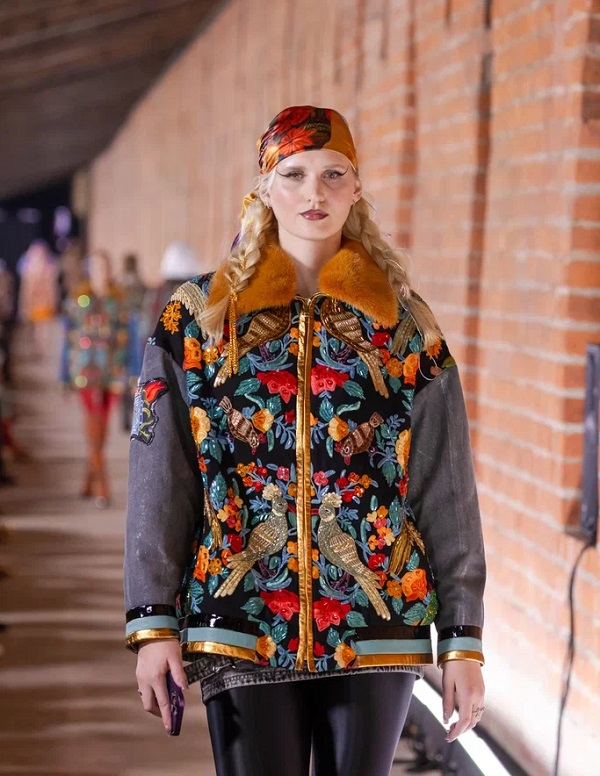
At the heart of the week was a profound appreciation for Russian heritage. This was most evident in the "Cultural Code" showcase, a special presentation by Wildberries that brought together six designers. This segment served as a microcosm of a larger trend, with designers transforming classic regional costumes into contemporary, wearable art.
The source of inspiration
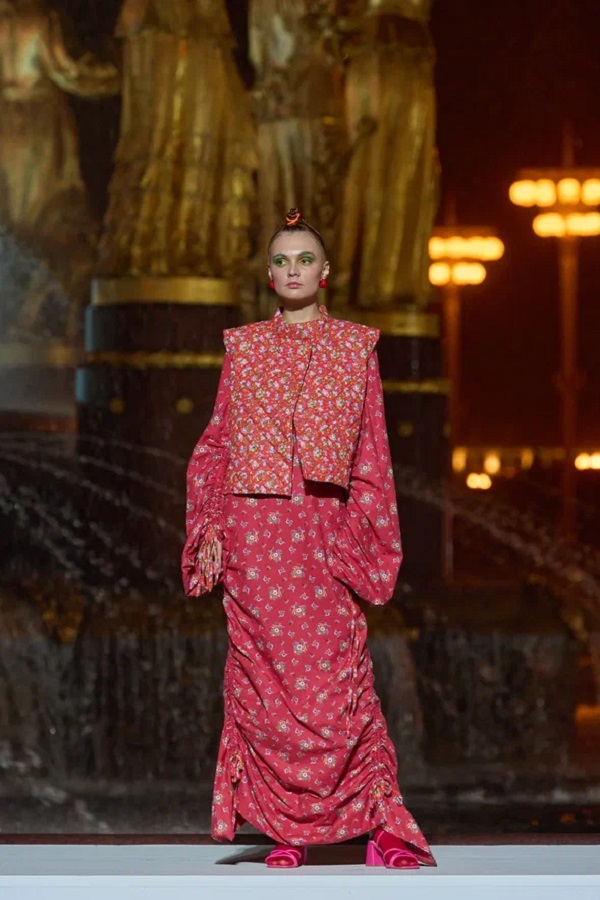
Designer Masha Andrianova's collection, "Istok" ("The Source"), offered a deeply personal interpretation of this theme. Inspired by her great-grandmother's writings, Andrianova created a line of flowing maxi dresses and tiered pinafores. The subtle layering and pared-back tailoring evoked a sense of intimate nostalgia, proving that the most profound designs often stem from personal history. Folklore and fairytales PiC-3 Victoria Tsiganova took a more direct, fairytale approach, specializing in the "à la russe" aesthetic. Her collection featured coats and denim jackets adorned with traditional motifs and Khokhloma-style painting. Topping off the looks with elaborate fur hats, Tsiganova transported the audience into a vivid, storied world of Russian folklore.
Legacy in every stitch

Collaborations between designers and historic textile mills highlighted the enduring legacy of Russian craftsmanship. The collection "The Shuya Bird" from Novikova DSGN and Shuya Textiles incorporated traditional patterns, including a recreated Baranov chintz. Similarly, Shuyskie Sitsy, a brand dedicated to reviving 19th-century prints, presented authentic sarafans and modernized folk attire, demonstrating how historical techniques can breathe new life into contemporary fashion.
A forward-looking heritage
This focus on heritage was not a nostalgic look backward but a vibrant, forward-looking movement. By reinterpreting their cultural codes, these designers affirmed that the deepest well of inspiration can often be found in the stories and traditions of home, ensuring Russian heritage continues to evolve on the global stage.
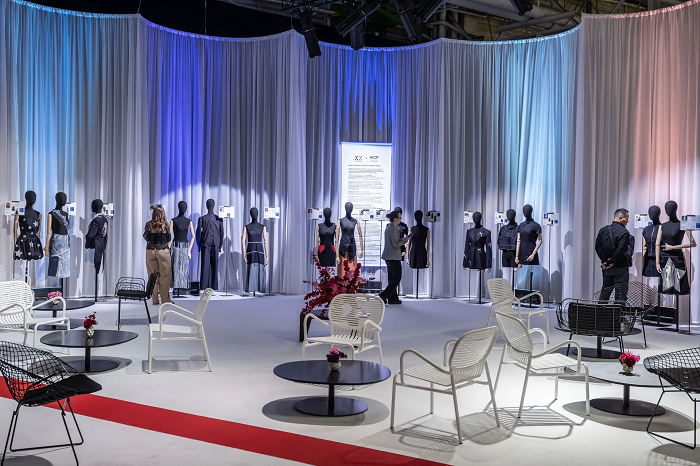
The 57th edition of Texworld Apparel Sourcing Paris successfully reinforced its status as the premier platform for the global textile and apparel industry.
Held from September 15-17, 2025, at the Parc des Expositions Paris-Le Bourget, the trade show brought together over 7,000 buyers and 1,300 manufacturers from more than 35 countries over three days. Organized by Messe Frankfurt, the event underscored Paris's central role in the international sourcing landscape.
The show was attended by visitors from the top five visiting markets concentrated in Europe: France, the United Kingdom, Italy, Spain, the Netherlands, and Germany. It registered a notable 25 per cent increase in attendance compared to the July 2024 edition, confirming the success of the strategic move to a September date.
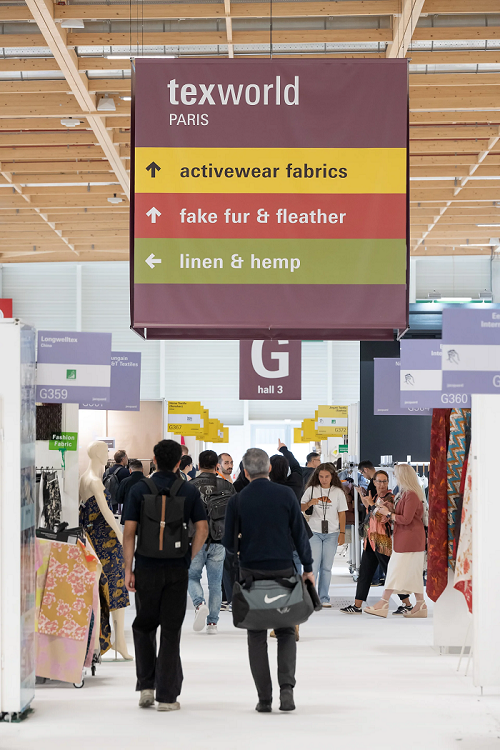
Enhanced experience and balanced offerings
The exhibition hall featured a new layout with two halls dedicated to product offerings and a third hall focused on services. The integration of relaxation areas, networking zones, and improved staging for trend forums successfully encouraged natural breaks and fostered better engagement.
For the first time ever, the show achieved a near-perfect balance in exhibitor numbers between textile offerings (Texworld Paris) and finished garments and fashion accessories (Apparel Sourcing Paris). Julien Schmoll, Marketing and Communication Director, Messe Frankfurt France, opines, this evolution directly reflects buyer response to current brand constraints.
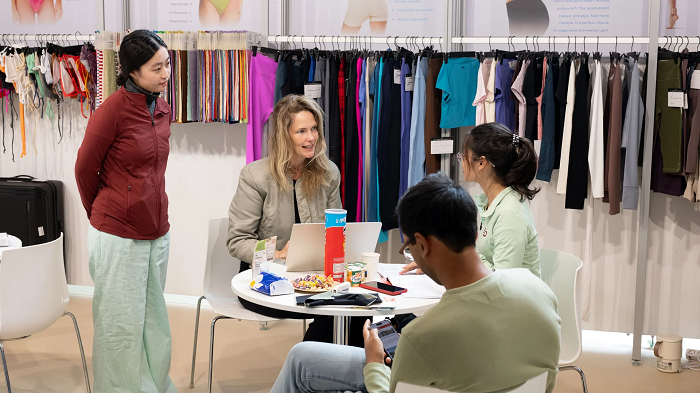
Expanding global reach and near-sourcing focus
With 1,300 companies from 35 countries and including the innovative Avantex sector, Texworld Apparel Sourcing Paris stands as Europe's leading sourcing platform. The show was attended by several major international players actively looking to strengthen their presence in Europe, viewing it as a more stable market.
These included newcomers like the Hong Kong-based Wing Ka Shing, which specializes in manufacturing knitted sweaters from its factory in DongGuan, China. The company attended the fair specifically to expand into the European market and mitigate the impact of tariffs imposed on products entering the United States.
The edition also focused on near-sourcing, with notable participation from Central and Eastern Europe (Armenia, Kyrgyzstan) and Southern Europe. It hosted the Near Sourcing Hub alongwith partner FourSource, The Hub featured eight companies physically present, alongside 28 others connected via FourSource’s B2B digital platform.
Innovation, sustainability, and the future of fashion The Avantex Paris sector served as a dedicated laboratory
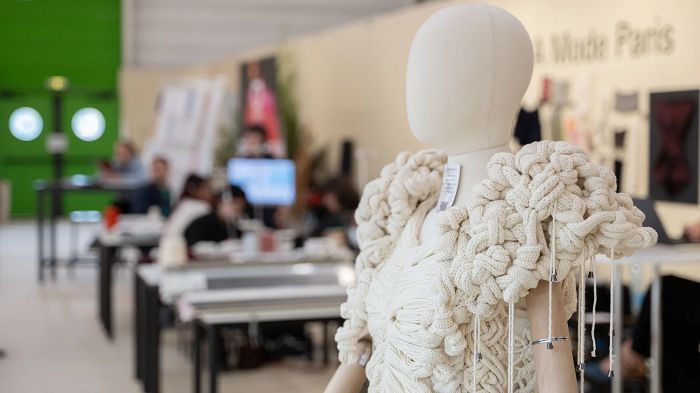
for innovation in sustainable fashion. It featured around thirty players across the HUB (solutions and services), the Designer HUB (design studios), and ReSources, which showcased companies selected by partner TCBL (Textile Clothing Business Labs).
The sector’s Agora hosted a packed program of conferences on key themes, including AI prospects, circularity, natural materials, and new consumption models. A highlight was the Bio Fashion Innovation Day, which showcased advanced projects in bio-based materials and eco-design.
The Avantex Fashion Pitch 2025 jury awarded the top prize to GoldenEye Smart Vision for its AI-based textile quality control system, which detects defects, optimizes production, and reduces waste. An Indian micro-enterprise and a collector and recycler of local waste, Green Worms, bagged a special prize.
Other show highlights included the Initiatives area, which showcased exceptional craftsmanship through live demonstrations by Pasari Textiles (Indian embroidery) and LISAA Mode students (knitwear). The Turkish industry’s creativity was also on display, while the China Textile Innovation Centre (CTIC) featured designs from selected Chinese manufacturers.
For the first time, the show experimented with new retail trends through live shopping sessions organized by the TikTok Shop teams. The event provided exhibitors a chance to test this new distribution channel, which TikTok launched for its 21 million French users in March.


